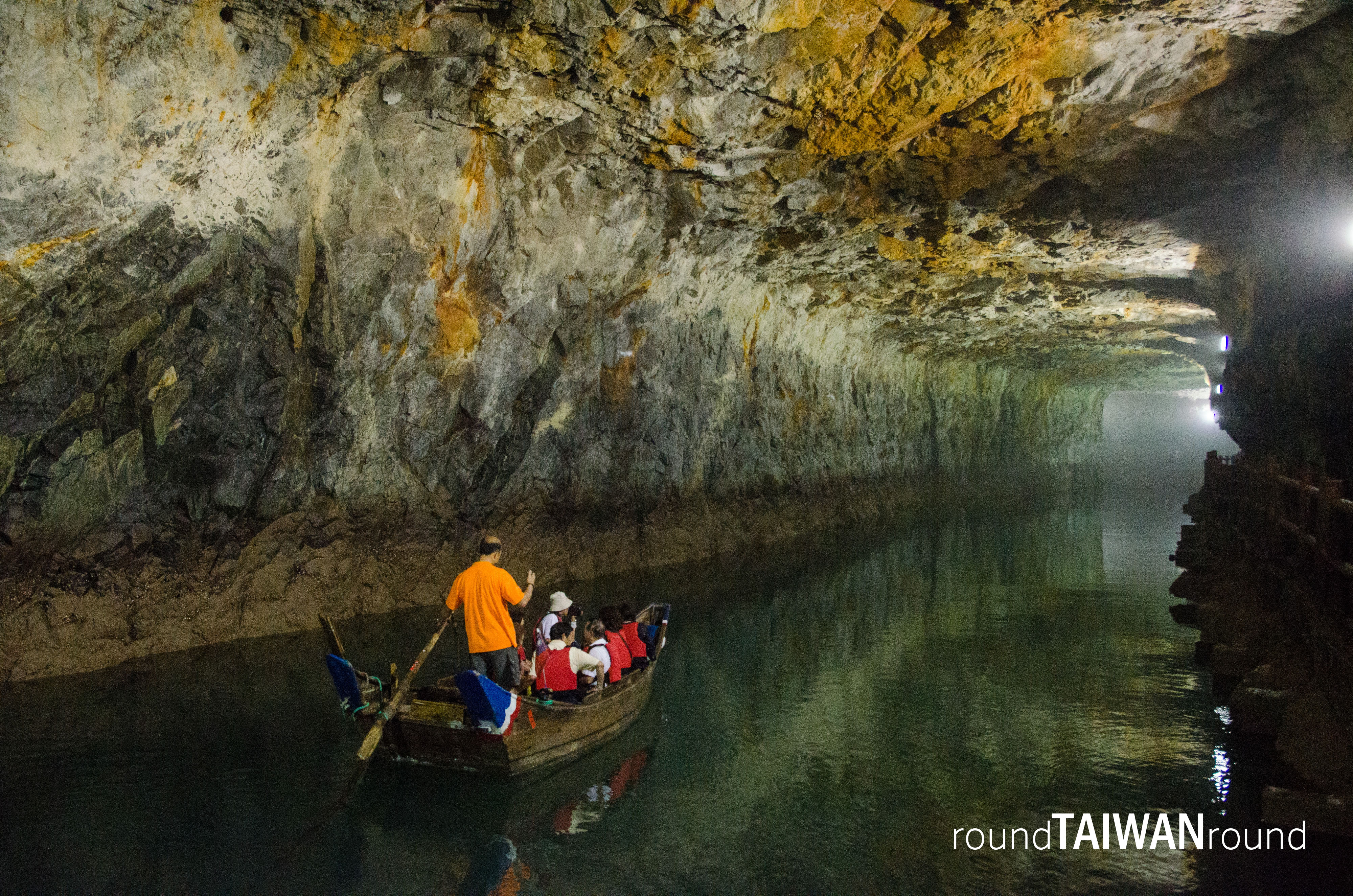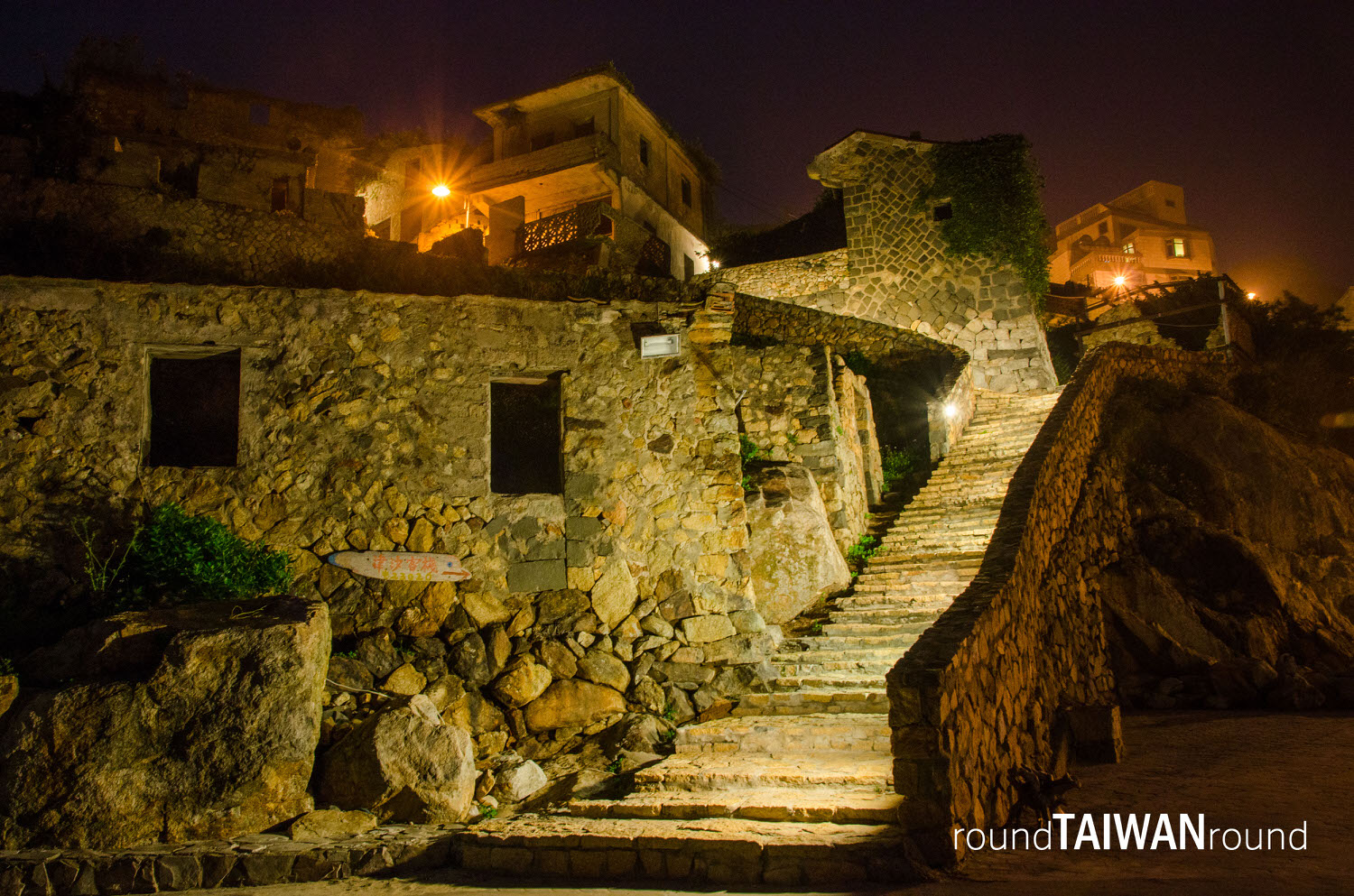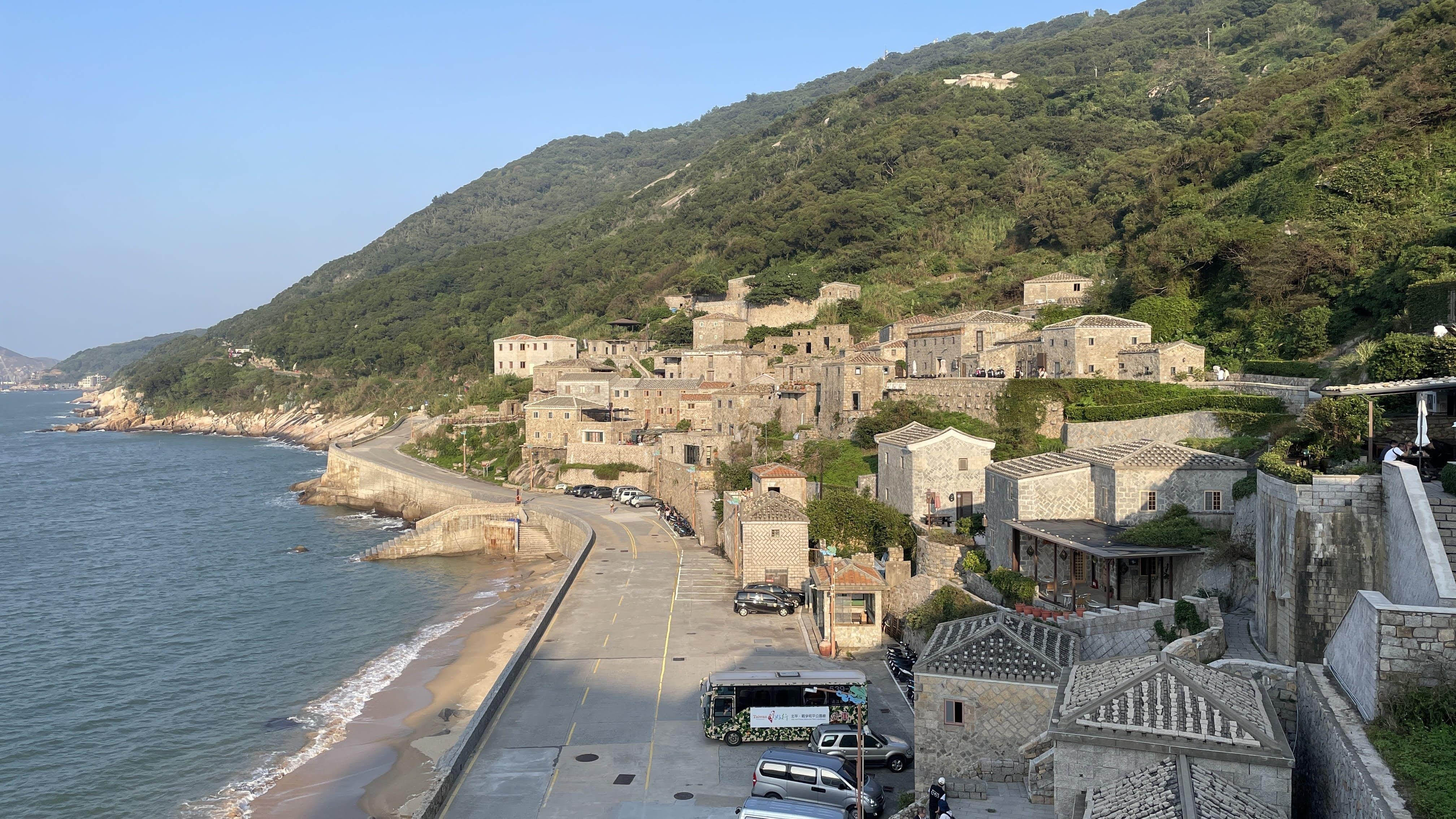
Matsu
- Home
- Matsu
Top 10 Must-Visit Matsu Attractions|Bucket List Guide
 1
1A Thread of Sky
A Thread of Sky is located in the east of Dongyin Island and is a walkable distance from Lienu Yikeng Cliff (烈女義坑) and Dongyin Lighthouse (東引燈塔). It is a wave cut gully made by two sea cliffs that was once part of a military controlled zone. Tunnels inside the cliffs are connected by a concrete bridge, but, unfortunately, the cliff is not open to tourists. The entrance to A Thread of Sky is situated next to the Tianwangao Military Camp (天王澳營區), where a narrow path points to how hidden this military zone of the past needed to be. Following the path downhill, it takes no more than five minutes to reach a wooden platform surrounded by high sea cliffs. Here, the only hint of the sky is a narrow thread in front of you, in which the sky seems to merge with the sea. The wind that gusts through it merges with the echoes of the waves below. To the right, four big red characters are carved into the cliff, meaning “listening to the waves in front of a thread of sky (天縫聆濤)”. We think these characters perfectly explain the feeling of being here.
 2
2Nangan Beihai Tunnel
The long and complex history between Taiwan and China is what makes Matsu and Kinmen famous. Today, war seems less likely than it once did, but many military facilities that endure from a bygone era have become tourist destinations worth visiting today. Just like you wouldn’t go to Kinmen without visiting Zhaishan Tunnel (翟山坑道) in Jingcheng Township (金城), you cannot go to Matsu without visiting Beihai Tunnel (北海坑道), the most magnificent tunnel on Nangan Island (南竿). The wall of the tunnel is made of hard, strong granite and was built using crude construction methods, mostly being excavated by manpower, along with dynamite. Once you know this, such a great feat of engineering as Beihai Tunnel might seem uncanny. In fact, because this tunnel was built out of strategic necessity, most locals on Matsu didn’t know about it until it was made into a tourist site relatively recently.
The Beihai Tunnel is located on a hillside near Dahan Stronghold (大漢據點) on the south coast of Nangan Island. A footpath runs alongside the grid-shaped waterway in the tunnel. At low tide you can walk down the 700 meters long waterway, which takes about 30 minutes in total. At high tide, the footpath is submerged by water so you will need to take a boat cruise with a specialist guide instead. At the entrance of the tunnel, there is a monthly tide table that you should take particular note of when you visit. 3
3Tunnel 88
Tunnel 88 is the first thing that comes to mind for many Taiwanese when they think of Matsu , in a combination of vivid images of Matsu’s famous alcohol and the military tunnels that scatter the islands. Tunnel 88 is entrenched in people’s minds as a result of a recent TV commercial. Located between Matsu Distillery Exhibition Hall (馬祖酒廠展示館) and Nangan Airport, when you arrive in the entrance of the tunnel, your eyes will be attracted by two walls of wine jugs and your nose by the slight scent of alcohol coming out of the tunnel. The stronger the aroma, the closer you are getting, as if it has magic power to slowly pull you into its hidden land.
The tunnel goes through the strong granite rock which is said to have been used as a cave for residents to hide away from pirates in times gone by. Only after the army of the Republic of China settled here and made the tunnel deeper and wider could it accommodate military vehicles. The length of the tunnel is 200 meters and the construction took 10 years, only being completed in 1974 for Chiang Kai-shek’s 88th birthday (hence the name Tunnel 88). The tunnel used to house the engine room of Chunghwa Telecom and only in 1992 did the military finally transfer it to Matsu Distillery, which turned it into a cellar. Since then, Matsu Distillery has used the fame of Tunnel 88 to boost its publicity. Nowadays, once you walk into the tunnel, you see a selection of wine which has been preserved for more than fifteen years. To the left of the middle sub-tunnel is a gaoliang sorghum wine storage area- the sheer quantity of alcohol is breath-taking! The tunnel is warm in winter and cool in summer, with the temperature averaging between 15-20℃, thereby making it a perfect storage place. At the entrance to the tunnel, guides provide tour services, and can answer any questions you may have about this impressive site. 4
4Statue of the Goddess Mazu
If you take a ferry from Nangan’s (南竿) Fuao Harbor (福澳港) to Xiju Island (西莒島) or Dongju Island (東莒島), it won’t be long before you see the giant Statue of the Goddess Mazu facing the sea. Situated in Matsu Village on Menqian Mountain (門前山), this giant statue of Mazu was constructed in 2009. Its total height is 28.8 meters, making it the tallest statue of the goddess in the world. Because it’s not easy to appreciate the statue from a short distance, we suggest that you follow the signs if walking from Matsu Village. The furthest place you will reach is a platform good for viewing Matsu Mazu Temple (馬祖境天后宮) and Matsu Port (Magang, 馬港) where warships are docked. Behind you, 100 steps lead to the giant statue, all of which need to scale to arrive. The steps finish with a massive ship-like structure that seems as big as Noah’s Ark, as if the Statue of the Goddess Mazu is standing on a giant boat. If you keep walking onto the body of the ship, you will arrive on a deck-like platform where you can see well into the distance. The giant statue in front of you seems even more imposing from this position. Around the statue, there are twelve sculptures that depict the legend of how Mazu attained her immortality.
Why don’t you come here on a cloudless sunny day to make a prayer to Mazu? Enjoy the breeze and appreciate the sunset. But remember, the platform is very high, so for those who are afraid of heights, stay clear of the fence! At night, the statue will light up in five colours. If you pass the west coast of Nangan, don’t forget to look up to see the beauty of the statue towering above you. 5
5Jinsha Village
Jinsha Village is located on Nangan’s Island’s (南竿島) south west coast and is a small fishing village, situated on the edge of Yuntai Mountain (雲台山). This is Nangan Island’s closest village to China. Its name, which uses a character with a similar pronunciation to the one for “golden” (金), comes from the color of its fine sand. Of all the villages on Nangan Island, Jinsha Village is well preserved enough to classify of the quaintest. Upon entering Jinsha Village, you will see children running to and fro in the big square. On one side of the square are dilapidated houses that have weathered many storms, while the other side has a Bed & Breakfast which has been renovated and still retains the old style of Hokkien architecture. Even though you can feel a sense of bleakness at many corners of the village, lively decorations add new ambience to the rustic village.
Some of the residents in Jinsha Village have come here to marry from China. Although you can tell from their accent that they are not Taiwanese, you can still sense the friendliness characteristic of the Taiwanese when chatting. This fishing village of the past has become a stylish place today. Some of the residents make their living by running Bed & Breakfasts, youth hostels, restaurants and cafes. Despite the modern developments, well-preserved Hokkien style stone houses cover the small hill of the village. Especially at night, with the installation of lights, it has an atmosphere unique to mountain towns, despite the many defense constructions that originated out of military needs still being visible today. Interestingly, even the public toilets have been renovated from a bunker. The last thing worth a mention is that the terrain around Jinsha Village is quite steep, with dramatic rises and falls. If you are not good at driving a scooter, you need to be especially careful.
 6
6Iron Fort
Iron Fort is located on the southern coast of Nangan (南竿) on an independent sea rock near Jinsha Village (津沙聚落). Because of the location’s difficult terrain and important strategic position, it was developed into a military base, with the middle of the sea rock excavated out to form a tunnel. Inside the tunnel there are canons, murder-holes, accommodation facilities, toilets, and a kitchen. Literally everything is there, it is a well-equipped fort for coastal defense. While the sea rock is covered with broken glass to act as a deterrent against air landings, the many tourists that come and go take the chill of wartime and death off the air. Nowadays, Iron Fort is a wonderful place for experiencing wartime culture and the view of the ocean with the sea breeze in your face. It is also a wonderful place for appreciating Blue Tears (藍眼淚, a type of florescent algae) on a summer evening.
 7
7Qinbi Village
Qinbi Village, situated on Matsu’s Beigan Island, is hailed as the "Matsu Mediterranean" or "Taiwan's Little Greece." This ancient fishing settlement is built right along the hillside, facing the sea. Its unique Min-Dong (Fujianese) style stone-masonry houses are clustered organically and layered down the slope toward the waterfront, creating a captivating scene.
Qinbi once flourished due to its thriving fishing industry, but the village declined as the industry waned and residents moved away. In recent years, however, a "Settlement Preservation and Old House Regeneration" project saw many of the traditional houses converted into charming guesthouses and restaurants, breathing new life into the area.
Walking through the village, visitors can admire the stone houses constructed from local granite, volcanic rock, and white-bluish stone. They can also observe the unique sight of "roof-pressing stones," which were used to weigh down the tiles against the powerful northeast monsoon winds. Furthermore, the faded, painted slogans on the walls serve as tangible reminders of its history as a military outpost.
Today, Qinbi is not only Matsu's most representative cluster of traditional Min-Dong architecture but also an ideal destination for travelers to experience the island's military history while being immersed in a Mediterranean-like, romantic atmosphere. Visitors can leisurely stroll through the narrow alleys or savor the unique tranquility and beauty at a scenic, seaside café.
 8
8Zhenge Daidan Monument
The name of this place, Zhenge Daidan, comes from a Chinese proverb (枕戈待旦) which means “sleeping with your head on a dagger-axe to await the arrival of the morning”. In other words, the proverb means that you are ready to enter the battlefield. When you enter Fuao Harbor (福澳港) by the Matsu Ferry (臺馬輪), you will see the huge monument, from which four massive red characters protrude. This is your signal that Nangan Island (南竿) is not far away. Indeed, it has almost become the symbol of Nangan in the minds of many travellers. Originally, this was a flat building situated on Fuqing Hill (福清嶺), only a 15 minute walk to the nearby Fuao Harbor (福澳港). The four characters were written by Chiang Kai-shek in 1958 when he came to Matsu, in order to remind soldiers of their mission to retrieve the lost territory of mainland China. His calligraphy was then enlarged and placed on the monument to commemorate his visit.
The main body of the flat building is now used as an exhibition hall and a souvenir shop. Walking onto the platform in front of the building, there is a great view of the whole of Fuao Harbor. If you find yourself with some time to kill waiting for the ferry to another island, why not wander down here to check out the beautiful view? 9
9Daqiu Island
Daqiu Island, located north of Beigan in Matsu (Lienchiang County), is an uninhabited island boasting rich ecological resources. It is most famous for its free-roaming Formosan Sika Deer (梅花鹿), earning it the nickname, "Taiwan's Nara."
The Sika deer population originated from a gift by the Taipei Zoo in the 1980s and has since multiplied to hundreds of animals. Visitors can walk along the ecological trails to observe, interact with, and even feed the deer with leaves at close range.
Daqiu Island was once inhabited, even having its own branch school. As residents gradually moved away, the island became uninhabited, but the ruins of the abandoned settlement remain, telling tales of its past.
The island features well-maintained circular hiking trails. Along the way, visitors can enjoy stunning coastal scenery, including sea-eroded landforms and dramatic cliff views. On clear days, it is also possible to spot the neighboring Gaodeng Island (高登島) in the distance. Summer is the prime time for bird watching, as boat trips to Daqiu often provide views of large flocks of terns (燕鷗) circling above the sea.
 10
10Andong Tunnel
Of all the military tunnels in Taiwan, the Pescadores, Kinmen and Matsu, this one on Dongyin Island (東引) is the most physically demanding to visit. Andong Tunnel is located on the southeastern coast of Dongyin Island, next to a military training center. Even standing in the entrance of the tunnel, it can feel uncanny how well it has been recreated. If you are looking into the tunnel from this position, you will see a seemingly bottomless tunnel at a 30-degree angle. The stairs and the lighting equipment in the tunnel are prepared for visitors’ convenience and the deeper you walk, the dimmer and cooler the atmosphere becomes in the yellow light. It is as if you were in the middle of a war, and makes you better appreciate just how precious peace is.
The tunnel to get to the entrance of Andong tunnel is 260 meters long, and a total of 464 steps, so it not recommended for people with reduced mobility to enter its depths. If you have successfully navigated the steps, then you will be rewarded with a glimpse of the real Andong Tunnel which is 640 meters long and able to be explored in all directions. Several extensions of the tunnel even reach the coast. Besides military utilities, such as ammunition depots, soldier dormitories, a Zhongshan room (中山室), a piggery and canons, there is also a sea viewing platforms and steep cliffs. Every April, this is a great place for seeing seagulls. But don’t be too happy about viewing the beautiful scene because on the way back you have to overcome the physical challenge of walking 400 steps, and this time it is uphill! So before visiting, don’t forget to consider your physical condition.
